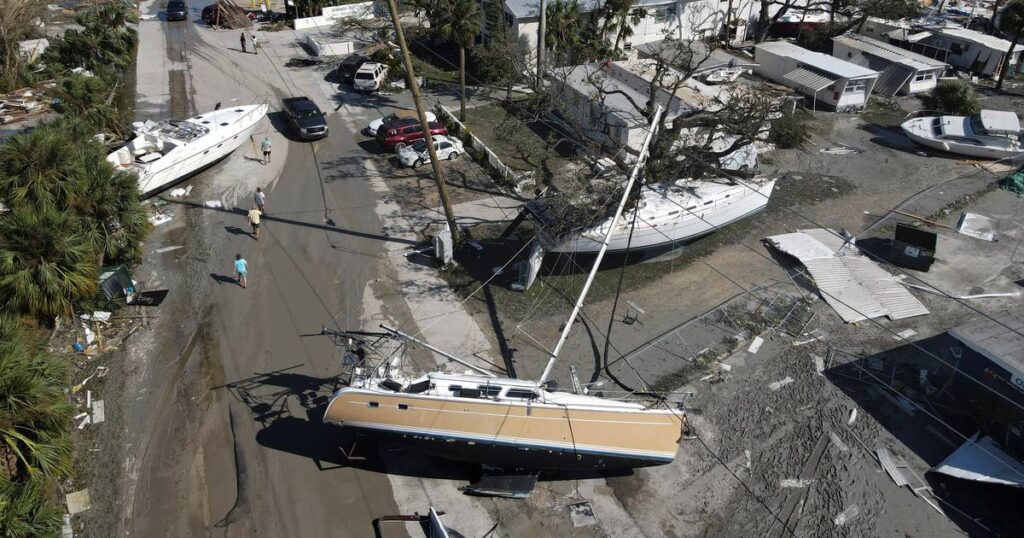After the deadly hurricane inflicted catastrophic damage in Florida and trapped thousands of people inside their houses, a reborn Hurricane Ian overnight threatened coastal South Carolina and the historic city of Charleston with heavy flooding.
By noon local time, large portions of Charleston’s downtown peninsula were already underwater due to sheets of rain that tore through trees and electrical wires. The 350-year-old city’s streets were largely deserted.
It was projected that Ian will make landfall just up the South Carolina coast during high tide, which would exacerbate flooding.
One of the strongest storms to have hit the US, Ian left a wide path of devastation after coming onshore on Florida’s Gulf Coast. The storm destroyed coastal businesses, inundated sections on both Florida’s coasts, tore homes away from their foundations, and left more than 2 million people without electricity.
In the US, at least nine deaths had been reported; this figure was very going to rise as search and rescue efforts continued.
According to CNN, Hurricane Ian has been linked to at least 25 fatalities.
According to the National Hurricane Center’s report at 11 a.m. local time on Friday (or 4 a.m. on Saturday NZT), Ian was located around 95 kilometres southeast of Charleston.
The Savannah River to Cape Fear were covered by the hurricane warning issued by the centre.
A storm surge of up to 2. 1 metres and up to 20 centimetres of rain were anticipated for some coastal parts of Carolina.
Thousands of people were stranded inside flooded homes and other structures damaged by Hurricane Ian in Florida. Rescue workers used boats and wade through riverine streets to free them.
According to Florida Governor Ron DeSantis, rescue teams have visited more than 3000 homes in the most severely affected areas, going door to door.
He remarked during a news conference in Tallahassee, “There’s truly been a Herculean effort.”
According to a research conducted soon after Hurricane Ian, climate change increased the amount of rain by at least 10%, according to its co-author, climate scientist Michael Wehner of Lawrence Berkeley National Lab.
An 80-year-old woman and a 94-year-old man who depended on oxygen devices that broke down due to power outages were among those died, according to the Sarasota County Sheriff’s Office.
The Volusia County Sheriff’s Office said that a 67-year-old man in New Smyrna Beach died after falling into rising water inside his home while waiting to be rescued.
After the hurricane earlier in the week, at least three fatalities were recorded in Cuba.
Businesses close to the shore in the Fort Myers region were completely destroyed, leaving twisted rubble. Alongside wrecked boats, broken docks drifted at strange angles. On lots where houses formerly stood, fires were smouldering.
William Goodison, who had lived in the Fort Myers Beach mobile home park where the wreckage was located for 11 years, stated, “I don’t know how somebody could have survived in there.” Goodison claimed that the only reason he survived is that he spent the storm at his son’s home inland.
About 60 houses made up of a park were damaged or destroyed beyond repair by the hurricane, including Goodison’s single-wide house.
Goodison and his son pushed two garbage cans filled with the meagre items he was able to save—a small air conditioner, some tools, and a baseball bat—across waist-deep water.
Broken trees, boat trailers, and other trash were all along the road leading into Fort Myers. When the storm surge inundated their engines, cars stalled and were left in the middle of the road.
To reach stranded persons, rescue workers cut through fallen trees.
Due to electrical and cellular failures, many people in the most severely affected areas were unable to call for assistance.
The Sanibel Causeway was partially destroyed as it crumbled into the water, blocking access to the barrier island’s 6300 residents.
In South Carolina, National Guard personnel were being prepared to assist with the aftermath, including any water rescues. Additionally, President Joe Biden in Washington accepted the state’s emergency declaration, which was a necessary move to speed up federal assistance for rehabilitation when Ian dies away.
Governor Roy Cooper of North Carolina advised citizens to get ready for heavy rain, strong gusts, and possibly power disruptions.
After battering Florida, Hurricane Ian is headed towards the Carolinas.

